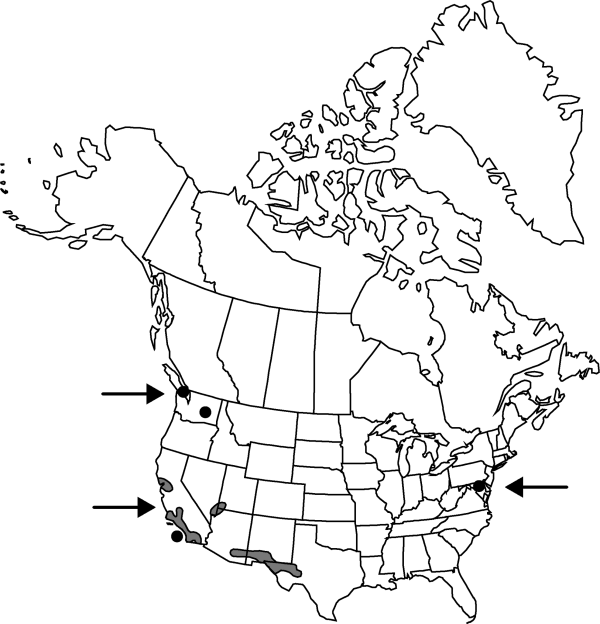Difference between revisions of "Atriplex semibaccata"
Prodr., 406. 1810.
FNA>Volume Importer |
imported>Volume Importer |
||
| (3 intermediate revisions by 2 users not shown) | |||
| Line 8: | Line 8: | ||
}} | }} | ||
|common_names=Creeping saltbush;berry saltbush | |common_names=Creeping saltbush;berry saltbush | ||
| + | |special_status={{Treatment/ID/Special_status | ||
| + | |code=W | ||
| + | |label=Weedy | ||
| + | }}{{Treatment/ID/Special_status | ||
| + | |code=I | ||
| + | |label=Introduced | ||
| + | }}{{Treatment/ID/Special_status | ||
| + | |code=F | ||
| + | |label=Illustrated | ||
| + | }} | ||
|basionyms= | |basionyms= | ||
|synonyms={{Treatment/ID/Synonym | |synonyms={{Treatment/ID/Synonym | ||
|name=Atriplex flagellaris | |name=Atriplex flagellaris | ||
|authority=Wooton & Standley | |authority=Wooton & Standley | ||
| + | |rank=species | ||
}} | }} | ||
|hierarchy=Chenopodiaceae;Atriplex;Atriplex subg. Atriplex;Atriplex sect. Semibaccata;Atriplex semibaccata | |hierarchy=Chenopodiaceae;Atriplex;Atriplex subg. Atriplex;Atriplex sect. Semibaccata;Atriplex semibaccata | ||
| Line 27: | Line 38: | ||
|elevation=10-1000 m | |elevation=10-1000 m | ||
|distribution=Ariz.;Calif.;D.C.;Nev.;N.Mex.;Tex.;Utah;Wash.;Australia. | |distribution=Ariz.;Calif.;D.C.;Nev.;N.Mex.;Tex.;Utah;Wash.;Australia. | ||
| + | |introduced=true | ||
|discussion=<p>The red-fleshy fruiting bracteoles are diagnostic of this introduced perennial, which is multi-stemmed from an often buried woody caudex.</p><!-- | |discussion=<p>The red-fleshy fruiting bracteoles are diagnostic of this introduced perennial, which is multi-stemmed from an often buried woody caudex.</p><!-- | ||
--><p>The Australian species <i>Atriplex</i> muelleri Bentham is somewhat similar. It has been has reported, but not verified, in the North American flora.</p> | --><p>The Australian species <i>Atriplex</i> muelleri Bentham is somewhat similar. It has been has reported, but not verified, in the North American flora.</p> | ||
| Line 37: | Line 49: | ||
-->{{#Taxon: | -->{{#Taxon: | ||
name=Atriplex semibaccata | name=Atriplex semibaccata | ||
| − | |||
|authority=R. Brown | |authority=R. Brown | ||
|rank=species | |rank=species | ||
| Line 52: | Line 63: | ||
|publication title=Prodr., | |publication title=Prodr., | ||
|publication year=1810 | |publication year=1810 | ||
| − | |special status= | + | |special status=Weedy;Introduced;Illustrated |
| − | |source xml=https:// | + | |source xml=https://bitbucket.org/aafc-mbb/fna-data-curation/src/2e0870ddd59836b60bcf96646a41e87ea5a5943a/coarse_grained_fna_xml/V4/V4_652.xml |
|genus=Atriplex | |genus=Atriplex | ||
|subgenus=Atriplex subg. Atriplex | |subgenus=Atriplex subg. Atriplex | ||
Latest revision as of 21:59, 5 November 2020
Herbs or subshrubs, perennial, decumbent-prostrate, unarmed, mainly 0.5–8 dm and spreading to 15+ dm wide, unarmed, white scurfy when young; branches not angled. Leaves many, alternate, subsessile or short petiolate; blade 1-veined, spatulate or obovate to oblong or elliptic, mainly 5–30(–40) × 2–9(–12) mm, base attenuate, margin remotely dentate to subentire, apex obtuse. Staminate flowers in small, terminal, leaf-bracteate glomerules 1.5 mm wide. Pistillate flowers solitary or in few-flowered clusters in almost all but distalmost leaves. Fruiting bracteoles red-fleshy at maturity, sessile or short stipitate, strongly veined, rhombic, convex, 3–6.6 × 2.8–4.5 mm, united at base, margin toothed, apex obtuse to acute. Seeds dimorphic: black, 1.5–1.7 mm, or brown, 2 mm. 2n = 18.
Phenology: Flowering spring–early winter.
Habitat: Saline waste places, along roads and sidewalks, in marshes, in various plant communities
Elevation: 10-1000 m
Distribution

Introduced; Ariz., Calif., D.C., Nev., N.Mex., Tex., Utah, Wash., Australia.
Discussion
The red-fleshy fruiting bracteoles are diagnostic of this introduced perennial, which is multi-stemmed from an often buried woody caudex.
The Australian species Atriplex muelleri Bentham is somewhat similar. It has been has reported, but not verified, in the North American flora.
Selected References
None.
